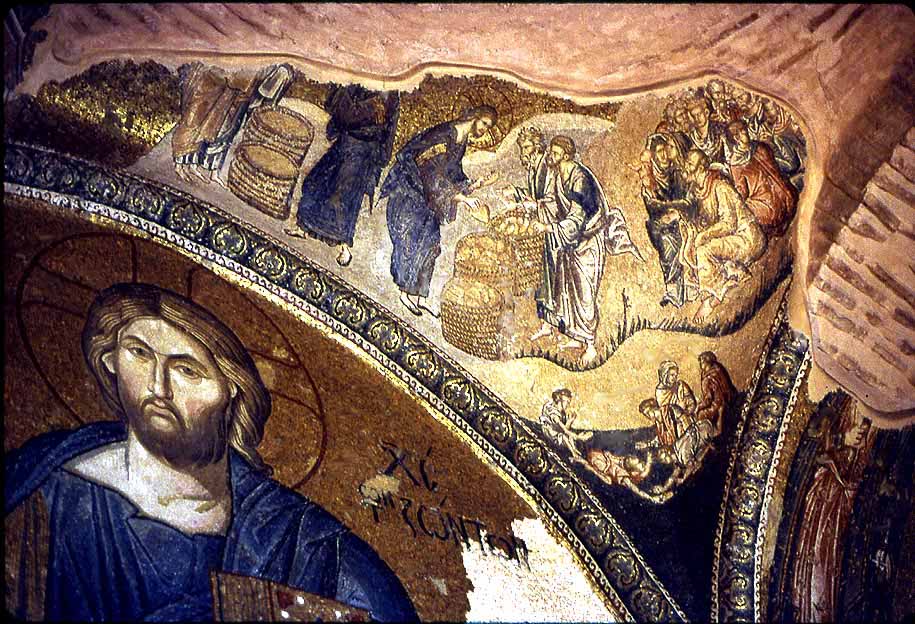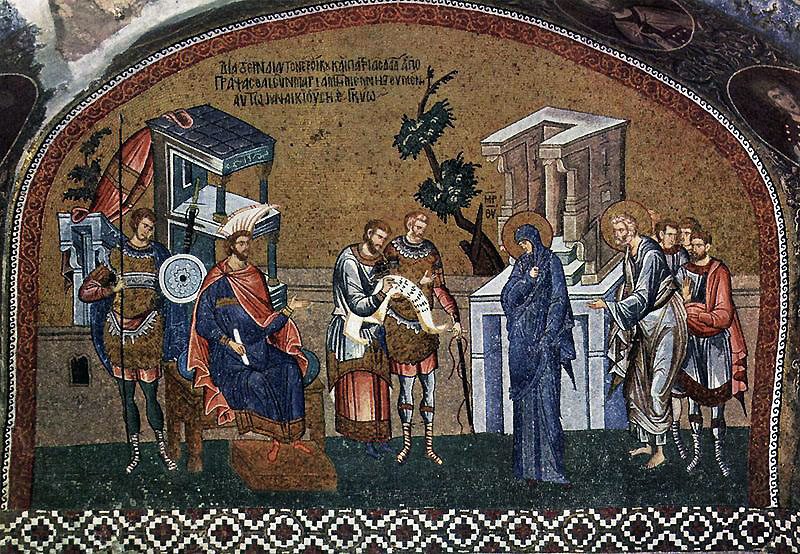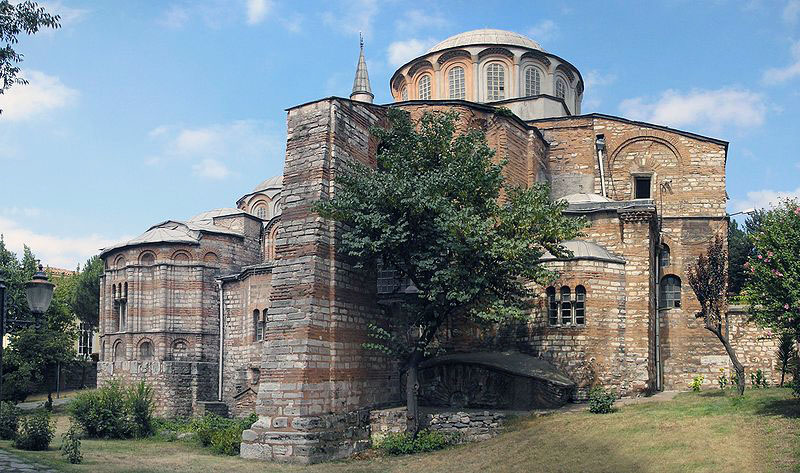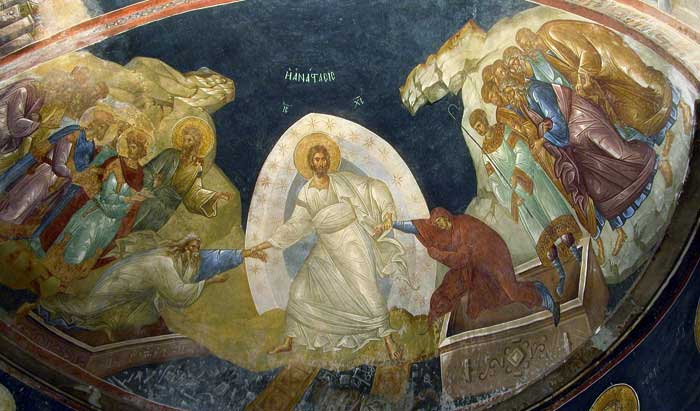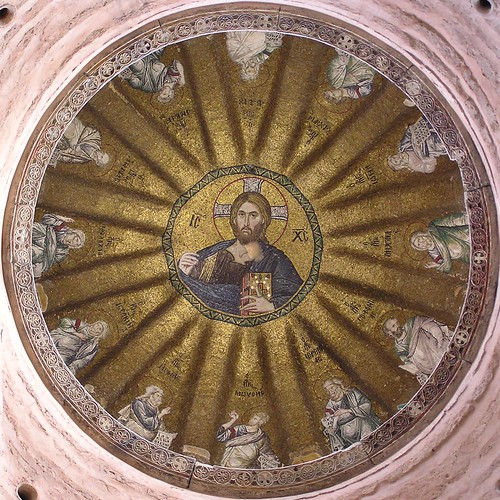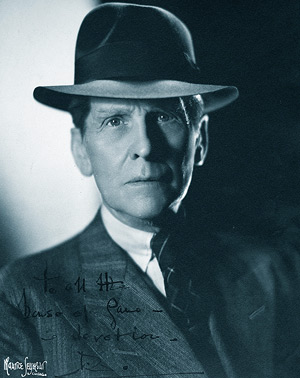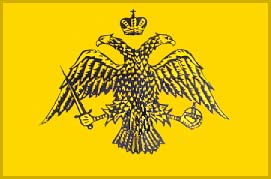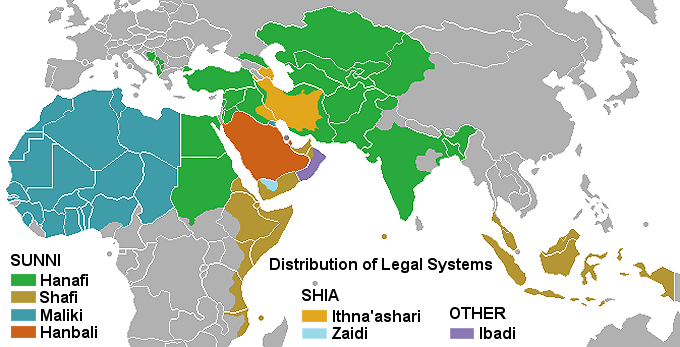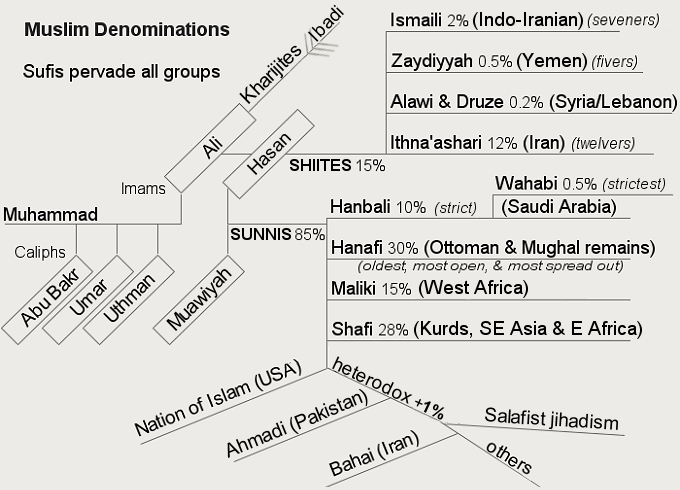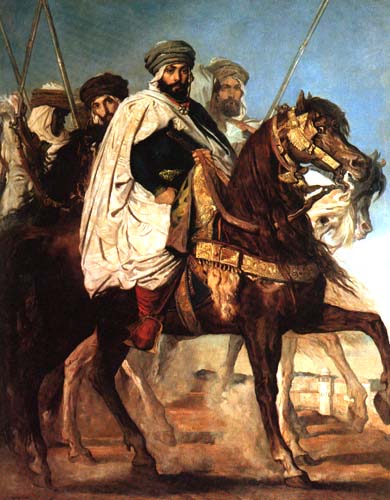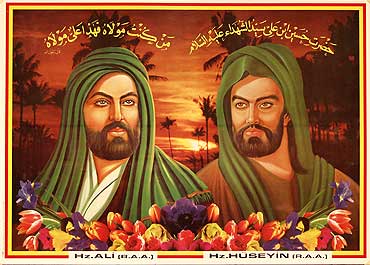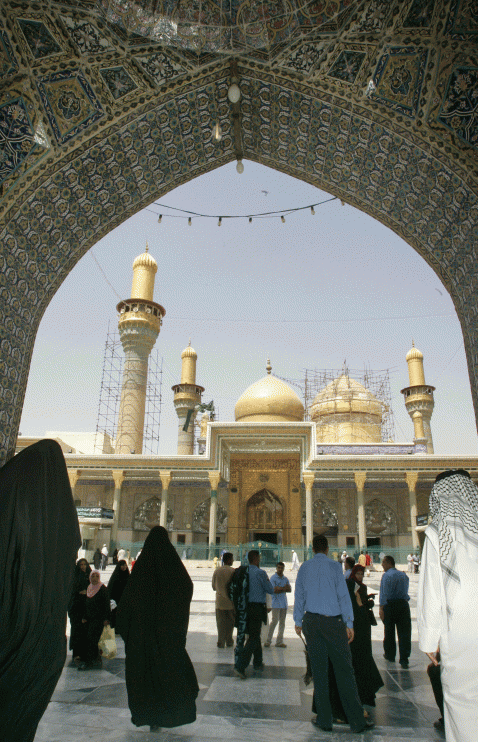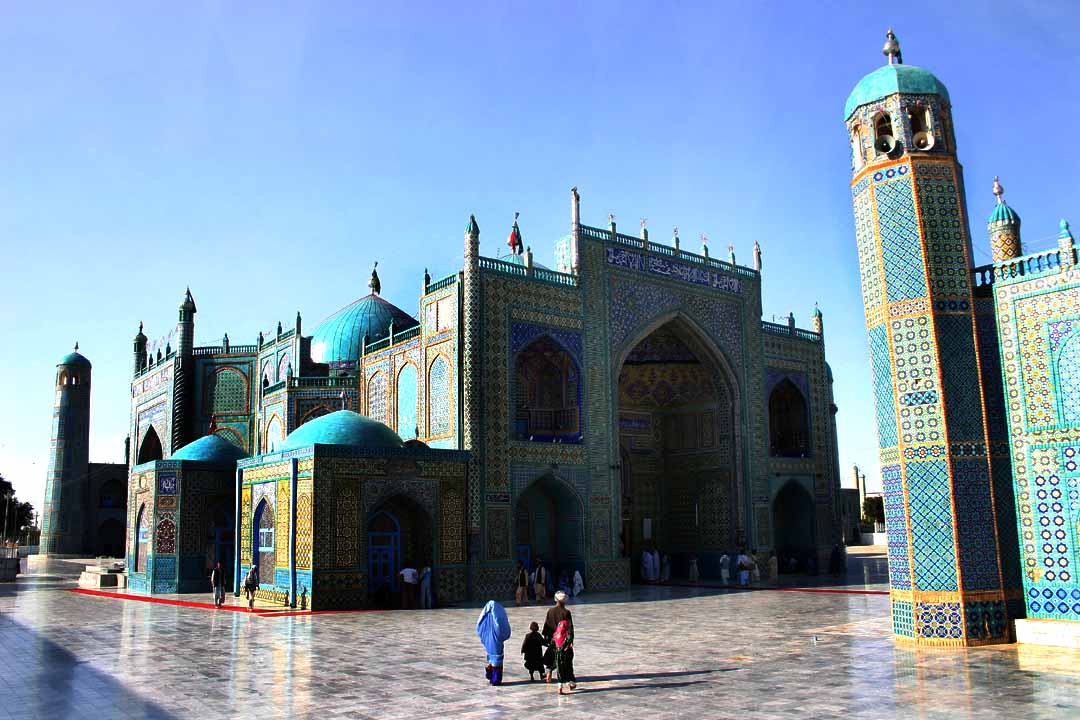Ten megapixel Mosaics!
St. Chora Church is not the most impressive of the Byzantine churches but it has arguably the best mosaics of the era (10-12th century), all executed when the fate of Constantinople was very clear with the city surrounded by the Ottoman forces. The church is best known for housing some of the best preserved mosaics and frescoes from the late-Byzantine period and considered among the very best in the world. (Photo: Krikor Tersakian)
St. Chora High Definition mosaic: St. Paul at St. Chora church. Unsurpassed quality.
It is funny, but every time I mention the Chora church to friends in Montreal, they think I am talking eggs, fruits and and pancakes ! You see, "Cora" is a pretty successful breakfast serving chain in Quebec owned by a Greek businesswoman, while I am trying to talk about the Chora church in Constantinople that houses the best Byzantine Mosaics and Frescoes, arguably the finest in the world!
The world had to wait until very recently for the introduction of High Definition TV and screens, but the incredible and unparalleled mosaics of St. Chora church were executed in "HD" in the 14th century! Some of the mosaic stones used are smaller than rice grains and the overall quality and execution are unparalleled. Mosaic is a very difficult art, and the Chora church is the ultimate temple of this lost but very noble Art.
St. Chora Church (known also as Kariye Museum) is a rather ordinary looking and medium sized church but amazingly it has some of the very best Byzantine mosaics of the 12-14 century to be found anywhere. Constantinople or Istanbul is long known as a city with layer upon layer of cultural riches and heritage dating from ancient times. But beyond all the obvious and universally acclaimed sites, St. Chora is a jewel that’s rarely seen or known. Therefore easily confused with the Montreal breakfast chain by some...
The Chora Church was originally built outside the defensive walls of Constantinople on the south of the Golden Horn, 4 Km west of HaghiaSophia and Topkapi. The church's full name was the Church of the Holy Saviour in the Country (Greek ἡ Ἐκκλησία του Ἅγιου Σωτῆρος ἐν τῃ Χώρᾳ, hē Ekklēsia tou Hagiou Sōtēros en tē Chōra). The name, Chora referring to its location originally outside of the walls, became the shortened and accepted name of the church. The original church on this site was built in the early 5th century, and stood outside of the 4th century walls of Constantine the Great. However, when Theodosius II built his impregnable land walls in 413–414, the church became incorporated within the city's defenses, but retained the name Chora. The church became an important stopping point for Pilgrims on their way to the Holy Land.
The world had to wait until very recently for the introduction of High Definition TV and screens, but the incredible and unparalleled mosaics of St. Chora church were executed in "HD" in the 14th century! Some of the mosaic stones used are smaller than rice grains and the overall quality and execution are unparalleled. Mosaic is a very difficult art, and the Chora church is the ultimate temple of this lost but very noble Art.
St. Chora Church (known also as Kariye Museum) is a rather ordinary looking and medium sized church but amazingly it has some of the very best Byzantine mosaics of the 12-14 century to be found anywhere. Constantinople or Istanbul is long known as a city with layer upon layer of cultural riches and heritage dating from ancient times. But beyond all the obvious and universally acclaimed sites, St. Chora is a jewel that’s rarely seen or known. Therefore easily confused with the Montreal breakfast chain by some...
The Chora Church was originally built outside the defensive walls of Constantinople on the south of the Golden Horn, 4 Km west of HaghiaSophia and Topkapi. The church's full name was the Church of the Holy Saviour in the Country (Greek ἡ Ἐκκλησία του Ἅγιου Σωτῆρος ἐν τῃ Χώρᾳ, hē Ekklēsia tou Hagiou Sōtēros en tē Chōra). The name, Chora referring to its location originally outside of the walls, became the shortened and accepted name of the church. The original church on this site was built in the early 5th century, and stood outside of the 4th century walls of Constantine the Great. However, when Theodosius II built his impregnable land walls in 413–414, the church became incorporated within the city's defenses, but retained the name Chora. The church became an important stopping point for Pilgrims on their way to the Holy Land.
Early in the 12th century, the church suffered a partial collapse, perhaps due to an earthquake and was rebuilt. However, it was only after the third phase of building, two centuries after, that the church as it stands today was completed.
Therefore the majority of the current building dates from 1077–1081, when Maria Ducaena, the mother-in-law of Alexius I Comnenus, rebuilt the Chora Church as an inscribed cross (quincunx), which was a popular architectural style of the time. Early in the 12th century, the church suffered a partial collapse, perhaps due to an earthquake. The church was rebuilt by Isaac Comnenus, Alexius's third son. However, it was only after the third phase of building, two centuries after, that the church as it stands today was completed.
The powerful Byzantine statesman Theodore Metochites endowed the church with much of its fine mosaics and frescoes. Theodore's impressive decoration of the interior was carried out between 1315 and 1321, thee mosaic-work being the finest example of the Palaeologus Renaissance. In 1328, Theodore was sent into exile by the Andronicus III but later was allowed to return and lived as a monk his last two years in the church. Finally in 1453 The Ottoman occupied the city through a defensive lapse very near the St. Chora church at Edirne Kapi. The Byzantine soldiers knew their surrounded city was doomed and were resting, praying and finding solace at the Chora.
Therefore the majority of the current building dates from 1077–1081, when Maria Ducaena, the mother-in-law of Alexius I Comnenus, rebuilt the Chora Church as an inscribed cross (quincunx), which was a popular architectural style of the time. Early in the 12th century, the church suffered a partial collapse, perhaps due to an earthquake. The church was rebuilt by Isaac Comnenus, Alexius's third son. However, it was only after the third phase of building, two centuries after, that the church as it stands today was completed.
The powerful Byzantine statesman Theodore Metochites endowed the church with much of its fine mosaics and frescoes. Theodore's impressive decoration of the interior was carried out between 1315 and 1321, thee mosaic-work being the finest example of the Palaeologus Renaissance. In 1328, Theodore was sent into exile by the Andronicus III but later was allowed to return and lived as a monk his last two years in the church. Finally in 1453 The Ottoman occupied the city through a defensive lapse very near the St. Chora church at Edirne Kapi. The Byzantine soldiers knew their surrounded city was doomed and were resting, praying and finding solace at the Chora.
After theOttoman conquest under the Sultan Fatih, this unique church Around became a mosque. Fifty years after the fall of Constantinople to the Ottomans (in 1453), Atık Ali Paşa, the grand vizier of Sultan Bayazid II, ordered the Chora Church be converted into a mosque — Kariye Camii. Due to the prohibition against images in Islam, the mosaics and frescoes were mostly left unharmed but were covered behind layers of plaster. This and frequent earthquakes in the region had taken their toll on the artwork until their restoration. Another earthquake in 1894 did not help either.
In 1948 the scholar Thomas Whittemore (Dumborton Oaks Byzantine Institute, Washington D.C.) who had done restoration work at the Haghia Sofia, sponsored also a audacious program of restoration of the unique art at the Chora, removing the plaster and restoring the artwork to its splendor. Awesome mosaics and frescoes were discovered, unique in their fine detail, displaying very subtle shadings and very rich colors that are unknown or lacking in earlier Byzantine mosaics. From that time on, the Chora church ceased to be a functioning mosque. In 1958, it was opened to the public as a museum — Kariye Müzesi. In today's Istanbul, St. ChoraHaghia Sofia in the pecking order. Still, it is a must see of universal importance.
A Brief history of the lost art of the mosaics
It is very difficult to elaborate about the exacts origins of the mosaic art as various civilizations from Mesopotamia to Rome have somehow excelled in their own right and not always in religious themes. Purely decorative mosaics with geometrical patterns were also mastered along with the mythological characters, saints, earthly or heavenly scenes etc. Early christians adopted mosaics fast and made them an integral part of church decorations. Mosaics were indeed extensively used both the secular dwellings as well as religious buildings throughout the Roman Empire and the Mediterranean basin.Despite all this, it is safe to argue that mosaics were most popular in the Eastern Roman Empire and hence were perfected by the Byzantines and therefore the Orthodox Christian rites. Others, such as Venice and other Italian cities also mastered the art as they were in constant friendly (and not so friendly) contact with Byzantium. The mosaics were an ancient roman tradition but in my view they reached their perfection under the Byzantines as witnessed in the St. Chora and a few churches and monasteries.
Mosaic is described as an art where the collage of small pieces of glasses, glazed clays, shells, pebbles, stones and even semi precious stones are used to create a decoration (images, landscapes, religious scenes, geometrical patterns etc.). The stones or glasses are cut to different shapes and the multicolor assemblage is used to create the final work "in situ" (on site, that is in a palace, cathedral, monastery etc). The glasses of different colors are referred to as tesserae and are combined to create the art.
With the rise of the Byzantine Empire from the 5th century onwards, centered on Byzantium (now Istanbul, Turkey), the art form took on new characteristics. These included Eastern influences in style and the use of special glass tesserae called smalti, manufactured in northern Italy. These were made from thick sheets of colored glass. Smalti have a rough surface and contain tiny air bubbles. They are sometimes backed with reflective silver or gold leaves to enhance the overall finish resulting in mesmerizing overall effects.
St. Chora Church dome: High Definition photo or mosaics of Highest quality? This mosaic, in the southern dome of the inner narthex, depicts the ancestry of Christ and his ancestors. In particular, Adam through Jacob are listed, along with the sons of Jacob. (Photo Mirari Erdoiza)
St. Chora: Christ the Savior (Left) and the miracle of Christ multiplying the bread to feed the 5000 followers. (Photo: Rolfgross)
HD screens are not needed here: You have to see to believe that this is not some modern poster, painting or a fresco. This is the mosaic just inside the main door. It depicts the famous image of Christ Pantocrator (Photo: pages.pomona.edu)St. Chora: Byzantine mosaic depiction of Christ. When the church was built in the 5th Century, Istanbul was still known as Constantin
St. Chora: Mosaic of the journey to Bethlehem (photo: choramuseum.com).The walls are decorated with superb 14th century mosaics, illustrating scenes from the life of Christ and the Virgin Mary. These are the finest masterpieces of Christian religious art to be found anywhere in the world. Paintings, rocks and architectural designs seen in the background make the pictures three-dimensional. The scenes are made with special care for them to look daily, lively and ordinary. The scenes are enriched with explicating stories near them.
Like the mosaics and the frescoes inside, the architecture of the St. Chora is artfully distorted, chaotic, asymmetrical and decorative. (Choramuseum.com)
Mosaic closeup: small mosaic ceramic pieces at Chora in need of repair, showing the stunning range of colors used. It’s not easy to do but it is well worth the effort. The interior walls are covered with exquisite Byzantine religious art that has no equal anywhere in the world. (Choramuseum.com)
The Frescoes in St Chora are also in High Definition: This is the Anastasis (or Resurrection) scene. Christ, who had just broken down the gates of Hell, is standing in the middle and trying to pull Adam and Eve out of their tombs. Behind Adam stand John the Baptist, David and Solomon. Others are righteous kings;(Photo:Mlahannas.de)
The St. Chora when it was still used as a Mosque then still called Kariye Camii (circa 1904). The mosaics were under then hidden under a layer of white plaster hiding them from view and few knew about their existence. Note the Golden Horn and Beyoglu Pera at the far left. This area now is totally surrounded by concrete working class dwellings and known to be a conservative Muslim Fatih neighborhood.
The Pammakaristos church: Another forgotten Byzantine jewel
Only a few hundred meters from the St. Chora stands another masterpiece of Byzantine culture, namely the Pammakaristos (Greek: Θεοτόκος ἡ Παμμακάριστος, "All-Blessed Mother of God") church which is today known as the Fethiye Mosque or museum. It does have very valuable mosaics even though not as elaborate as those at the St. Chora. It is in the area called Çarsamba in Fatih neighborhood and was built on the fifth hill of Constantinople in the beginning of 12th century and then rebuilt in the 13th century by Michael Glabas Ducas Tarchaniotes, nephew of the emperor Michael VIII Palaeologos. After the fall of the City in 1453, Pammakaristos was used as a nunnery and then it became the see of the exiled Orthodox Patriarchate from 1455 until 1587.
In 1590, the church was inevitably converted into a mosque Fethiye (conquest or conqueror), in order to commemorate the conquest of Georgia and Azerbaijan by the Turks under the reign of Sultan Murad III during the Iranian war. A part of the apse was removed and a niche (Mihrab) was built showing the direction of Mecca for Muslim prayers along with a minaret and a religious teaching school or madrassah.
In 1590, the church was inevitably converted into a mosque Fethiye (conquest or conqueror), in order to commemorate the conquest of Georgia and Azerbaijan by the Turks under the reign of Sultan Murad III during the Iranian war. A part of the apse was removed and a niche (Mihrab) was built showing the direction of Mecca for Muslim prayers along with a minaret and a religious teaching school or madrassah.
Pammakaristos church was then neglected for a long period until its restoration in 1949 by the Byzantine Institute of America (see details below). Just like the St. Chora, in the mid 20th century the frescoes and mosaics were cleaned and the famous church became a museum but it is far less visited than the St Chora and understandably so.
At the entrance, there is a well preserved frescoes on the wall with "three wise men", and some fragments of other frescoes. Inside the dome and the interior walls of the parekkleison are covered with mosaics from the 14th century. The dome is decorated with Christ Pantokrator and the Twelve Prophets. In the apsis, there are figures of Christ with Virgin Mary and John the Baptist forming the Deesis, and archangels watching them. In the vaults and arches, there are scenes of the Baptism, and of several saints and monks of the church (www.greatistanbul.com)Pammakaristos Pantocrator church dome mosaics: (Photo: phool 4xc FlickR)
Pammakaristos: St. Gregory Illuminator (Սուրբ Գրիգոր Լուսաւորիչ) mosaic 14th century: St Gregory or Krikor was the driving force behind the conversion of Armenia from paganism to Christianity in 301 A.D. and hence the founder of the Armenian Apostolic church. He was initially imprisoned by the Armenian king Tirdad I (Տրդատ թագաւոր) but he managed to convert the King to Christianity along with the Nation (the first in the world to do so). His son Aristakes was his successor as head of the newly formed Church and took part to the famous First council of Nicaea in 325 A.D., the first ecumenical council of bishops of the Christian Church under Constantine. The above mosaic at the Pammakaristos church is very interesting but a bit odd given the conflict and competition opposing the Byzantines to the independent Armenian Apostolic church.
This mosaic at Haghia Sofia may be the most famous of them all, but the overall quality of the surviving artwork (frescoes and mosaics) at St Chora is in a different league. (Photo: Krikor Tersakian)
Real life Indiana Jones: In 1948, Thomas Whittemore (1871 – 1950) and Paul A. Underwood, from the Byzantine Institute of America and the Dumbarton Oaks Center for Byzantine Studies, sponsored a program for restoration of the Chora in Istanbul. Thomas Whittemore was a scholar, archaeologist, born in Cambridge, Massachusetts in 1871. His good personal relationship with Ataturk enabled him to gain permission from the government to start the preservation and restoration of the Haghia Sophia mosaics in 1931. Under the plaster he discovered close to a thousand years of history—in silver, gold, marble, and sparkling glass cubes put together into a parade of saints and influential sinners which stretches from 537 to 1453 A.D., when the Turks came marching in, and then started work at the Chora restoring the place to its splendor (Choramuseum.com)
Bicephalous Eagle: The Byzantine Imperial flag: The double-headed eagle was the symbol of the Palaiologos, the last Greek-speaking "Roman" dynasty to rule from Constantinople. Emperor Michael VIII Palaiologos recaptured Constantinople from the catholic Crusaders in 1261, from a state based in Asia Minor; the double-headed eagle symbolized the dynasty and was kept despite the fact that virtually all of the Asian possessions were being gradually gobbled up by the Turks. This symbol was also adopted by the Greek Orthodox Ecumenical Patriarchate as well as the Russians.
Real life Indiana Jones: In 1948, Thomas Whittemore (1871 – 1950) and Paul A. Underwood, from the Byzantine Institute of America and the Dumbarton Oaks Center for Byzantine Studies, sponsored a program for restoration of the Chora in Istanbul. Thomas Whittemore was a scholar, archaeologist, born in Cambridge, Massachusetts in 1871. His good personal relationship with Ataturk enabled him to gain permission from the government to start the preservation and restoration of the Haghia Sophia mosaics in 1931. Under the plaster he discovered close to a thousand years of history—in silver, gold, marble, and sparkling glass cubes put together into a parade of saints and influential sinners which stretches from 537 to 1453 A.D., when the Turks came marching in, and then started work at the Chora restoring the place to its splendor (Choramuseum.com)
Bicephalous Eagle: The Byzantine Imperial flag: The double-headed eagle was the symbol of the Palaiologos, the last Greek-speaking "Roman" dynasty to rule from Constantinople. Emperor Michael VIII Palaiologos recaptured Constantinople from the catholic Crusaders in 1261, from a state based in Asia Minor; the double-headed eagle symbolized the dynasty and was kept despite the fact that virtually all of the Asian possessions were being gradually gobbled up by the Turks. This symbol was also adopted by the Greek Orthodox Ecumenical Patriarchate as well as the Russians.
I grew up an Lebanon, a country considered to be an open air museum. The country is small in size, but few can claim to have seen all the historical sites the cradle of ancient Phoenicia has to offer. From the earliest human settlements all the way to Hellenistic, Roman, Byzantine, Arab, Crusader, Mameluke, Ottoman or French colonial rule, the country is a one stop shopper's paradise. However all is not so rosy. Some sites are unprotected and the concrete urban jungle threatens most. The Lebanese National Museum with all its unique Phoenician and other treasures was heavily damaged and sacked during the civil war. But this is by no means a tragedy unique to Lebanon. Archaeological sites across the region are left unprotected and are crying for help.
Another tragedy happened in Baghdad upon the absurd Iraqi invasion by all time great American visionary leader and philosopher called George W. Bush. More than ten thousands antiquities of different sizes were looted in April 2003 from the National museum. These unique treasures were illegally sold all around the world, but fortunately most but not all were eventually recovered. In a typical answer as to why the US forces did not secure the museum from theft and looting, the official answer from the General Richard Myers was that while the looting was taking place at the museum, lots of people were dying because of the fighting. Therefore the museum with the unique Mesopotamian artifacts was not a priority for the attacking troops...
As for mosaics, the picture is even bleaker in the region because of the very fragile nature of these assemblages. For example when I was a kid, we used to sometimes visit the Roman site in the Village of Beit Meri near Beirut where there are open air mosaics and we used to actually walk on them just for fun! Yes, we were pretty ignorant, innocent and supervision free to walk on these thousand years mosaics. I still deeply regret doing so.
The sorry state of some archaeological sites in the Near East and elsewhere is beyond belief even though deliberate acts of vandalism seem to be rare. But is this acceptable ?
There are not many options available other than the complete protection of all historical sites with the help (both financial and technical) of the International community, agencies, universities and even philanthropists who understand a basic fact: what is lost today is never recovered.
Another tragedy happened in Baghdad upon the absurd Iraqi invasion by all time great American visionary leader and philosopher called George W. Bush. More than ten thousands antiquities of different sizes were looted in April 2003 from the National museum. These unique treasures were illegally sold all around the world, but fortunately most but not all were eventually recovered. In a typical answer as to why the US forces did not secure the museum from theft and looting, the official answer from the General Richard Myers was that while the looting was taking place at the museum, lots of people were dying because of the fighting. Therefore the museum with the unique Mesopotamian artifacts was not a priority for the attacking troops...
As for mosaics, the picture is even bleaker in the region because of the very fragile nature of these assemblages. For example when I was a kid, we used to sometimes visit the Roman site in the Village of Beit Meri near Beirut where there are open air mosaics and we used to actually walk on them just for fun! Yes, we were pretty ignorant, innocent and supervision free to walk on these thousand years mosaics. I still deeply regret doing so.
The sorry state of some archaeological sites in the Near East and elsewhere is beyond belief even though deliberate acts of vandalism seem to be rare. But is this acceptable ?
There are not many options available other than the complete protection of all historical sites with the help (both financial and technical) of the International community, agencies, universities and even philanthropists who understand a basic fact: what is lost today is never recovered.
The great 19th century Armenian Humorist / Satirist Hagop Baronian (1843 Edirne-1891 Constantinople) summed it best: ''Look to your rear side to see in front of you'' (Ետեւդ նայիր որ առջեւդ տեսնես). That is, History is not just the past, it is also the best interpretation and the road map to understand and somehow predict the future.
Tyre, Lebanon: Neglected open air mosaics. It is in the Roman period that mosaics in Lebanon started to appear.The Hellenistic period from 400 B.C until the Roman period have not yielded any mosaic pavement in Lebanon particular during its prosperous period of the 2nd century A.C-Mosaics continue to flourish during the Byzantine period until the Arab conquest. Important finds of mosaic pavements have been made in many archaeological sites, in churches and in ancient houses. Lebanon has become thus one of the most important centers for the study of mosaics. (Photos: Cedarrick)
Krikor Tersakian June 2010, Canada





